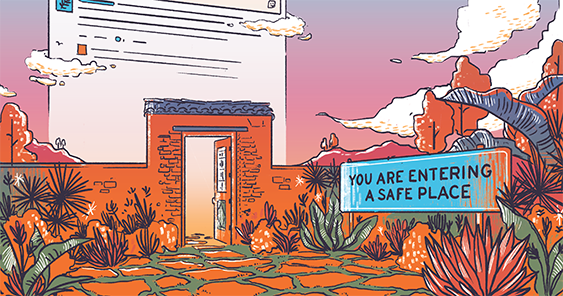(Words by Louise Saludo; Illustration by Lazir Caluya)
Social media was once the platform that balanced the internet’s free-flowing information, allowing the public a convenient means of proactive participation. Online communities grew by supporting shared advocacies, but their rapid growth was overridden by the hate that suddenly permeated social media, and Rappler was a firsthand witness.
The vision for the news network was pure, but after the 2016 elections, many smeared the platform with ad hominem attacks and false dichotomies. The death threats and rape threats caused a chilling effect on readers, with many silenced through cyber-bullying. The hate tarnished the vision of Rappler as a space for intellectual discourse.
It didn’t take long for Rappler to push back.
Turning the power of social media back onto the haters, Rappler created the campaign #NoPlaceForHate to detoxify hate-mongering in their platform. Ms. Stacy de Jesus, the site’s Head Social Media Manager, shares more.
Your job must have been difficult since the elections. Do you think the nitpicking of netizens affects your work as a journalist? How do you propagate the truth despite all the hate?
Social Media has always been a tough problem to crack—it’s constantly evolving so it requires a social media manager, like me, to evolve with it. I expected it to be more challenging during the elections. As digital and civic engagement progressed, it was inspiring to see a more active citizenry on social media. However, forces at play took advantage of the opportunities and started attacking anyone who did not agree with them. Most of the time, the level of engagement was inhumane. It was death by a thousand cuts and it created a climate of fear that pushed people to become silent.
It was not my work as a journalist per se that was affected, but more so the principles that inspire me to do what I do—to empower citizens to speak up and engage in smart conversations and respectful debates, which indicate a thriving democracy. It was disheartening to see democracy flailing because of the hatred, but at the end of the day, it’s not about me or how I feel.
Journalists are in the business of truth-telling, and despite what’s happening; we must continue to weather the storm to do what we do. The spread of hate online is unfortunate, but journalists since time immemorial have faced obstacles that are far worse.

In 2016, Rappler applied the #NoPlaceforHate campaign in order to create a peaceful comment section. Were there any times that the hate got too strong? Since the day of its implementation, were there any changes?
When Rappler started in 2012, we had no other broadcasting platform—no TV, radio, or print. People discovered us on their own on social media and that gave them a sense of ownership of the brand, and rightfully so since they are stakeholders in the growth of Rappler. We have always held ourselves accountable to the public: we embody transparency and have opened the doors for our readers to feel free to praise and criticize us. Most of our readers abide by the rules of engagement. Simple moderation policies govern the spaces we own, and that helps guarantee that our comments section continues to be a safe space for debates—a democratic right—where people can speak their mind, be heard, and agree to disagree.
It was a highly engaged community — until one day we noticed a shift in behavior in our comments section. The place that used to be a treasure trove for intellectual debates became a venue for attacking those with dissenting opinions. The page was swarmed by several accounts throwing ad hominem attacks at us or to another person. It seemed like our space was raided and our original community was attacked and threatened into silence.
The #NoPlaceForHate campaign took a stand against the hatred. Freedom of speech does not mean license to smear reputation and ruin credibility. Nor does it mean the freedom to be irresponsible and to defame. As the moderator, it’s my job to ensure civility in our discussions. It was us assuring our community that there will be zero tolerance for ad hominem, so they can come out again and engage in smart conversations as much as they want to.
We received positive feedback for the #NoPlaceForHate campaign. Some said there was a time when they unfollowed our updates because the comments were too toxic. This campaign prompted them to return. Since the start of the campaign, we’ve noticed much less trolling in our comments. Our comments section is not perfect, but respectful disagreements are happening again. The campaign also inspired other organizations to adapt the campaign or to create their own.
For everything Rappler has gone through, in your perspective, why does it still continue to serve the people to this day?
There is a climate of fear and uncertainty on social media. Now more than ever, people need to feel they are not alone. In Rappler, we stand for many freedoms and freedom calls for courage. We are moved by those who stand for others and are hopeful that together we can #InspireCourage.
Journalism is not prestigious and is also seldom rewarding. We knew that coming in. Despite the challenges, we know this is a good time to be a journalist. A digital propaganda war is happening and there are lots of stories to be told during wartime. It would be cowardly — and frankly, unbecoming of a journalist — to look away.
From observing the comments section, why do Filipinos react so negatively to intellectual discourse? Was it always this way or was there a time when it was less destructive?
I think a lot of the hatred was manufactured. Anger spreads fastest online, and several propaganda machines initiated this angry behavior until some real people caught the bug. However, I still believe that Filipinos are civil and reasonable by nature. The trolls and the people with troll-like behavior can only go so far in real life.
Readers will play a large part in the success of the #NoPlaceforHate campaign. What else can your loyal readers do to create a safe space other than report the trolls? Who else do you think would play a role in reinforcing this campaign?
We cannot do this alone so we invite everyone to make this their personal advocacy too. It starts with self. If we all commit to removing the bashing, the lies, the non-sequiturs, and baseless accusations from our newsfeeds, we can bring it back to where it used to be: a safe place for conversations.
It’s not too late to tame the hate. We don’t want to wake up one morning to an angry nation that the generation after us would have a tough time rebuilding.
If we all choose to start dealing with the matter at hand by not tolerating bad behavior, we can leave this digital space better than we found it.









